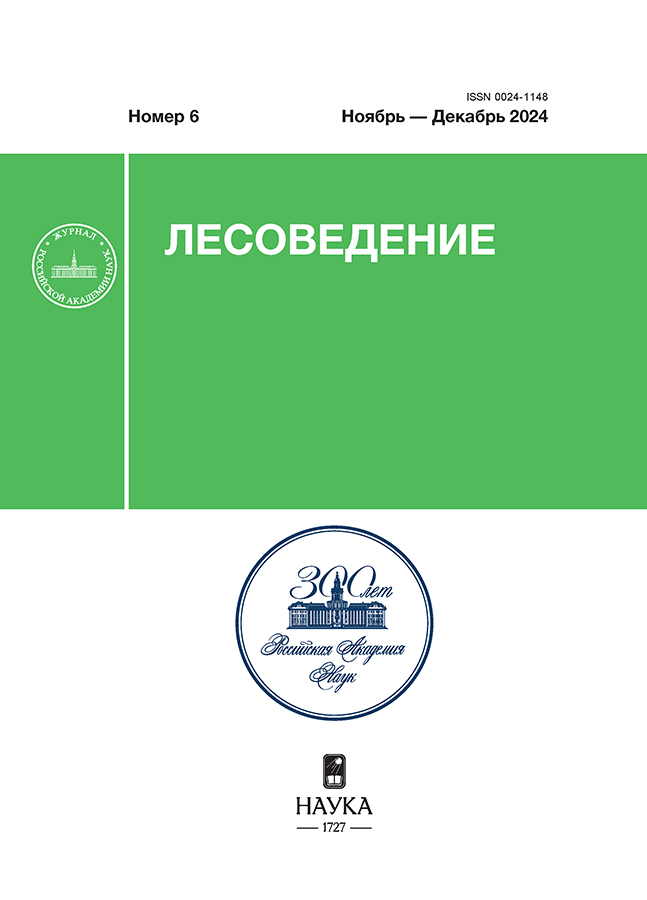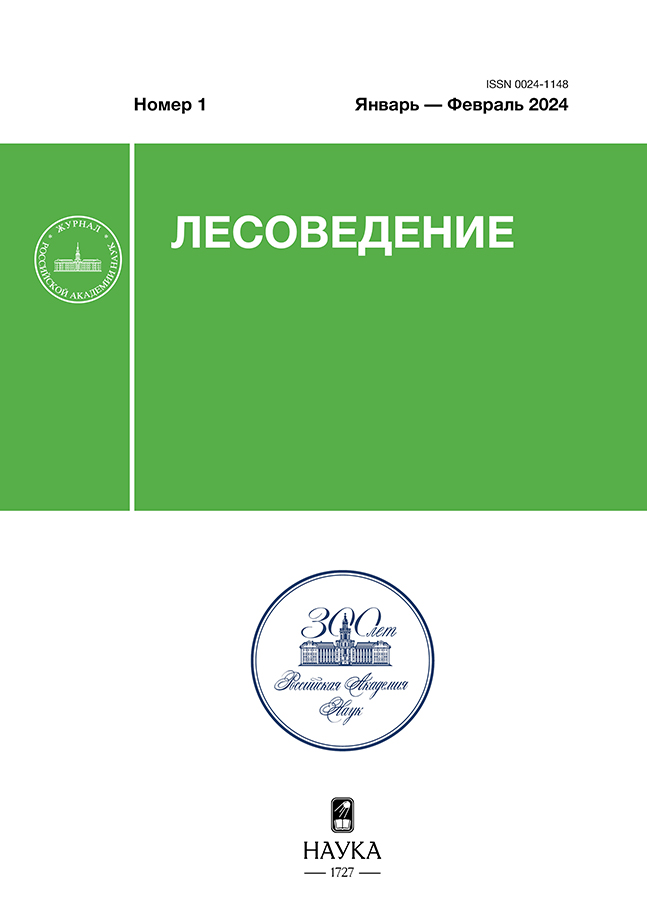Growth and productivity of trees in forest crops of Norway spruce in Smolensk-Moscow Upland
- Authors: Merzlenko M.D.1, Bryntsev V.А.2, Kozhenkova A.A.2
-
Affiliations:
- Institute of Forest Science, RAS
- The Principal Botanical Garden of the RAS
- Issue: No 1 (2024)
- Pages: 38-42
- Section: RESEARCH
- URL: https://freezetech.ru/0024-1148/article/view/674025
- DOI: https://doi.org/10.31857/S0024114824010045
- EDN: https://elibrary.ru/smarko
- ID: 674025
Cite item
Abstract
The issues of diagnosing tree growth in a plantation are of a significant scientific and practical interest. The purpose of the research was to substantiate the use of the indicator “tree height at 10 years of age” to diagnose their subsequent growth and productivity in Norway spruce (Picea abies (L.) H. Karst.) forest crops. 70-year-old spruce monocultures were chosen as objects for the study. Model trees were chosen on trial plots (TP) using the method of step-by-step proportional representation. After cross-cutting, they were subjected to a complete analysis of the trunk and as a result, the height of the tree at 10 years of age and the height, diameter and volume of the trunk at 70 years of age were calculated. It has been established that with age in spruce forest plantations, some of the trees that started off stronger may eventually lose their ranking positions, while the initially weaker trees, on the contrary, can raise up through the ranks. At the same time, the more average trees in the plantation remain at the centre of such a process; according to all three inventory indicators (height, diameter and the volume of the trunk), their position becomes the most stable with age. Thus, the height at 10 years of age can be considered as a diagnostic sign indicating further growth of trees in forest plantations.
Keywords
Full Text
About the authors
M. D. Merzlenko
Institute of Forest Science, RAS
Email: bryntsev@mail.ru
Russian Federation, Sovetskaya st. 21, Uspenskoe, Odintsovsky District, Moscow Oblast, 143030
V. А. Bryntsev
The Principal Botanical Garden of the RAS
Author for correspondence.
Email: bryntsev@mail.ru
Russian Federation, Botanicheskaya st. 4, Moscow, 127276
A. A. Kozhenkova
The Principal Botanical Garden of the RAS
Email: bryntsev@mail.ru
Russian Federation, Botanicheskaya st. 4, Moscow, 127276
References
- Anuchin N.P., Lesnaya taksatsiya (Forest taxation), Moscow: Lesnaya promyshlennost’, 1982, 552 p.
- Borodin A.M., Kul’tury eli v povyshenii proizvoditel’nosti lesov (Spruce crops in increasing forest productivity), Moscow: Lesnaya promyshlennost’, 1972, 144 p.
- Eitingen G.R., Izbrannye trudy (Selecta), Moscow: Sel’khozizdat, 1962, 500 p.
- Georgievskii N.P., O razvitii nasazhdenii pri rubkakh ukhoda (On the development of plantings during thinning), In: Razvitie russkogo lesovodstva (Development of Russian forestry), Moscow–Leningrad: Gosudarstvennoe lesotekhnicheskoe izdatel’stvo, 1948, Issue 1, pp. 112–179.
- Kozhenkova A.A., Zakharova M.I., Osobennosti rosta posadochnogo materiala sosny obyknovennoi v lesnykh pitomnikakh Smolensko-Moskovskoi vozvyshennosti (Characteristics of growth of planting material of Scots pine in the forest nurseries of the Smolensk-Moscow region), Vestnik Moskovskogo gosudarstvennogo universiteta lesa — Lesnoi vestnik, 2015, Vol. 19, No. 6, pp. 34–37.
- Markova I.A., Agrotekhnika i tekhnologiya sozdaniya vysokoproduktivnykh kul’tur eli i sosny promyshlennymi metodami na Severo-zapade RSFSR. Avtoref. dis. d-ra s.-kh. nauk (Agrotechnics and technology for creating highly productive spruce and pine crops by industrial methods in the Northwest of the Russian SFSR. Extended abstract of doctor’s agric. sci. thesis), Leningrad: Leningrd. lesotekh. akademiya, 1989, 40 p.
- Maslakov E.L., Formirovanie sosnovykh molodnyakov (Development of pine young-growth), Moscow: Lesnaya promyshlennost’, 1984, 165 p.
- Merzlenko M.D., Gurtyachenko Y.G., Optimal’naya vysota trekhletnikh seyantsev eli (Optimal height of three-year-old spruce seedlings), Lesokhozyaistvennaya informatsiya, 1990, No. 11, pp. 30–31.
- Merzlenko M.D., Mel’nik P.G., Sukhorukov A.S., Lesovodstvennaya ekskursiya v Losinyi Ostrov (Silvicultural excursion to Losiny ostrov), Moscow: MGUL, 2008, 128 p.
- Merzlenko M.D., Shestakova E.Y., Biologicheskaya produktivnost’ iskusstvennykh molodnyakov eli (Biological productivity of artificial young spruce trees), Nauchnye trudy Moskovskogo gosudarstvennogo universiteta lesa, 1992, Issue 257, pp. 38–45.
- Mironov V.V., Ekologiya khvoinykh porod pri iskusstvennom lesovozobnovlenii (Ecology of conifer during artificial reforestation), Moscow: “Lesnaya prom-ost’”, 1977, 232 p.
- Moiko M.F., Kovalev M.S., Rost lesnykh kul’tur v zavisimosti ot razmerov seyantsev (Growth of forest crops depending on the size of seedlings), Lesnoe khozyaistvo, 1977, No. 1, pp. 52–54.
- OST 56-69-83 (OST 56-69-83 Sample plots for forest management), Moscow: TsBNTIleskhoz, 1984, 59 p.
- Pigarev F.T., Belyaev V.V., Sungurov R.V., Kompleksnaya otsenka kachestva posadochnogo materiala i ego primenenie na Evropeiskom Severe (Comprehensive assessment of the quality of planting material and its use in the European North), Arkhangelsk: AILiLKh, 1987, 14 p.
- Rogozin M.V., Nasleduemost’ vysoty u sosny obyknovennoi i eli sibirskoi v Permskom krae (Hereditability of height at a pine ordinary and fur-trees Siberian in Perm region), Khvoinye boreal’noi zony, 2010, Vol. 27, No. 1–2, pp. 181–184.
- Rogozin M.V., Razin G.S., Lesnye kul’tury Teploukhovykh v imenii Stroganovykh na Urale: istoriya, zakony razvitiya, selektsiya eli (Forest crops of the Teploukhovs on the Stroganovs’ estate in the Urals: history, laws of development, spruce selection), Perm: Permskii gosudarst. issled. un-t, 2012, 210 p.
- Stahl E.G., Provenance and plus tree selection different age of trees. An analysis of a 41-years old provenants trial with Picea abies (L.) Karst, in South Western, Sweden department of forests research, Report No. 16, Swedish university of agricultural sciences, Gartenberg, 1985, pp. 1–30.
- Werner M., Selection methods and its influence on a large scale propagation programme in Sweden, Forest tree improvement, 1987, No. 20, pp. 79–101.
Supplementary files














